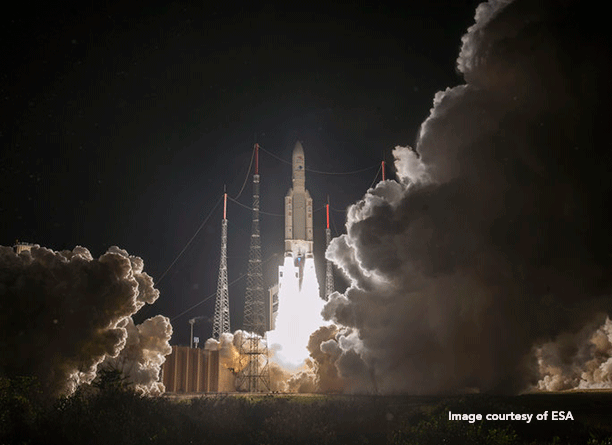Bepi Colombo, on the way to Mercury

At 01.45 GMT (03.45 CEST) on 20 October the BepiColombo mission was successfully launched atop an Ariane 5 rocket from the European Spaceport of Kourou (French Guiana).
BepiColombo, a joint mission of the European Space Agency (ESA) and the Japanese Aerospace Exploration Agency (JAXA), comprises a Mercury Transport Module (MTM), built by ESA, and two independent orbiters, ESA’s Mercury Planetary Orbiter (MPO), nicknamed “Bepi”, and JAXA’s Mercury Magnetospheric Orbiter (MMO) or “Mio”. These have inbuilt solar panels, electrical propulsion systems, several antennae and a complex thermal management system. All these tools have been designed to withstand Mercury’s harsh environment.
ESA’s Mercury Planetary Orbiter (MPO), fitted with 11 instruments, will basically map Mercury’s surface, taking high-resolution images and analyzing the makeup of the soil (unknown hitherto) and the magnetic field. JAXA’s Mercury Magnetospheric Orbiter (MMO), for its part, octagonal in shape and covered in mirrors, carries four instruments to study the magnetic field and look for dust particles while also analyzing Mercury’s thin atmosphere, the exosphere.
One of the biggest challenges facing this mission is the sun’s huge gravitational pull, which will hinder a stable orbital insertion of the spacecraft around Mercury, calling for more energy than sending a spacecraft to Pluto. After the launch, once outside the Earth’s “gravity well”, BepiColombo will then have to brake continually against the sun’s gravitational pull. MTM’s ion thrusters, built by ESA, will supply the necessary low thrust during the long cruise phase, using technology previously put through its paces in ESA’s GOCE mission for studying the earth’s gravity and the SMART-1 mission to the moon.
Bepi Colombo is due to reach Mercury in 2025. One year later its science operations will begin, possibly then lasting for two years. The scientific data will be collected by ESA’s receiving antenna in Cebreros, Ávila, and then sent on to ESAC, Madrid, where it will be processed and distributed to the researchers. The spacecraft’s instructions will be sent up from the European Space Operations Centre (ESOC) in Germany.
Within the mission GMV has developed the Control Center for ESA’s European Space Operations Centre, including operational support during the launch phase. It has also designed the Science Ground Segment (SGS) for the European Space Astronomy Centre (ESAC). Another notable activity has been development of the orbital control system in association with operational support during the launch and routine phases, including the complex transfer phase until the satellite is successfully inserted into Mercury orbit. During the initial phases, under the aegis of ESOC, GMV also helped out in the necessary mission analysis activities for designing the whole ensemble of this interplanetary exploration mission. Lastly, GMV has led various important studies for defining the system and the relative navigation algorithms used onboard the satellites.
Bepi Colombo is Europe’s first ever mission to Mercury, the smallest and least explored planet of the inner solar system. It is also the first to send two orbiters to take simultaneous and complementary measurements of the planet’s dynamic environment.
Before going into Mercury orbit Bepi Colombo has a seven-year voyage ahead of it, during which time it will perform nine planetary flybys, the Earth once, Venus twice and Mercury six times. This means the mission will not only tell us more than we ever knew before about the innermost planet of our solar system but also, on a broader scale, will give us priceless insights into the evolution of such systems in general, gleaning invaluable information on the formation and development of planets orbiting close to their progenitor stars in exoplanetary systems.